Jiajun Zhang
National Laboratory of Pattern Recognition, Institute of Automation, CAS, Beijing, China, School of Artificial Intelligence, University of Chinese Academy of Sciences, Beijing, China
Parallel Scaling Law: Unveiling Reasoning Generalization through A Cross-Linguistic Perspective
Oct 02, 2025Abstract:Recent advancements in Reinforcement Post-Training (RPT) have significantly enhanced the capabilities of Large Reasoning Models (LRMs), sparking increased interest in the generalization of RL-based reasoning. While existing work has primarily focused on investigating its generalization across tasks or modalities, this study proposes a novel cross-linguistic perspective to investigate reasoning generalization. This raises a crucial question: $\textit{Does the reasoning capability achieved from English RPT effectively transfer to other languages?}$ We address this by systematically evaluating English-centric LRMs on multilingual reasoning benchmarks and introducing a metric to quantify cross-lingual transferability. Our findings reveal that cross-lingual transferability varies significantly across initial model, target language, and training paradigm. Through interventional studies, we find that models with stronger initial English capabilities tend to over-rely on English-specific patterns, leading to diminished cross-lingual generalization. To address this, we conduct a thorough parallel training study. Experimental results yield three key findings: $\textbf{First-Parallel Leap}$, a substantial leap in performance when transitioning from monolingual to just a single parallel language, and a predictable $\textbf{Parallel Scaling Law}$, revealing that cross-lingual reasoning transfer follows a power-law with the number of training parallel languages. Moreover, we identify the discrepancy between actual monolingual performance and the power-law prediction as $\textbf{Monolingual Generalization Gap}$, indicating that English-centric LRMs fail to fully generalize across languages. Our study challenges the assumption that LRM reasoning mirrors human cognition, providing critical insights for the development of more language-agnostic LRMs.
MARS2 2025 Challenge on Multimodal Reasoning: Datasets, Methods, Results, Discussion, and Outlook
Sep 17, 2025
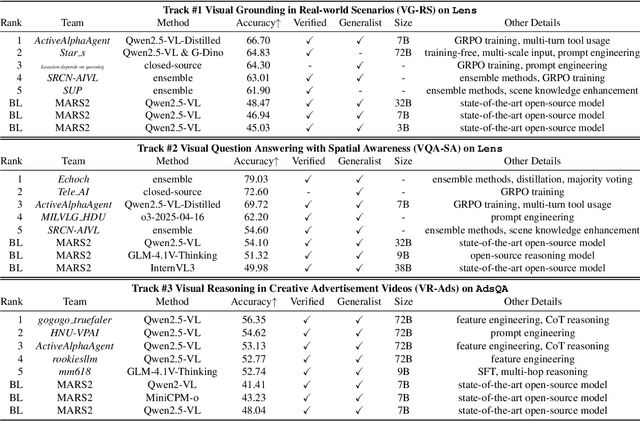

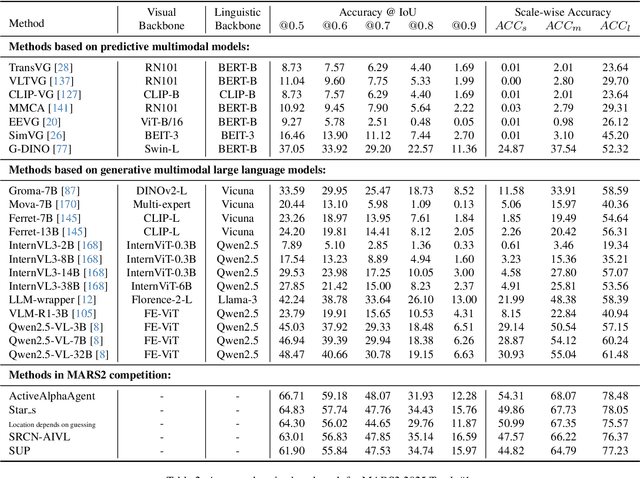
Abstract:This paper reviews the MARS2 2025 Challenge on Multimodal Reasoning. We aim to bring together different approaches in multimodal machine learning and LLMs via a large benchmark. We hope it better allows researchers to follow the state-of-the-art in this very dynamic area. Meanwhile, a growing number of testbeds have boosted the evolution of general-purpose large language models. Thus, this year's MARS2 focuses on real-world and specialized scenarios to broaden the multimodal reasoning applications of MLLMs. Our organizing team released two tailored datasets Lens and AdsQA as test sets, which support general reasoning in 12 daily scenarios and domain-specific reasoning in advertisement videos, respectively. We evaluated 40+ baselines that include both generalist MLLMs and task-specific models, and opened up three competition tracks, i.e., Visual Grounding in Real-world Scenarios (VG-RS), Visual Question Answering with Spatial Awareness (VQA-SA), and Visual Reasoning in Creative Advertisement Videos (VR-Ads). Finally, 76 teams from the renowned academic and industrial institutions have registered and 40+ valid submissions (out of 1200+) have been included in our ranking lists. Our datasets, code sets (40+ baselines and 15+ participants' methods), and rankings are publicly available on the MARS2 workshop website and our GitHub organization page https://github.com/mars2workshop/, where our updates and announcements of upcoming events will be continuously provided.
ACE-RL: Adaptive Constraint-Enhanced Reward for Long-form Generation Reinforcement Learning
Sep 05, 2025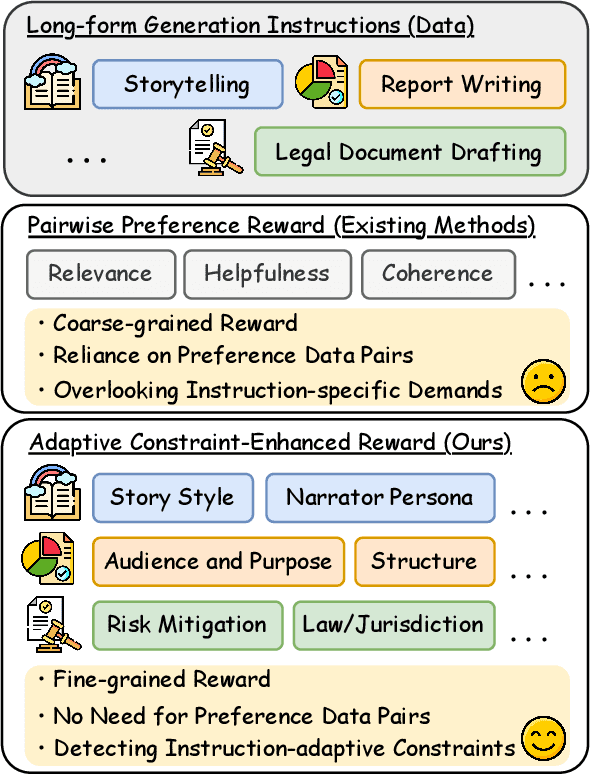
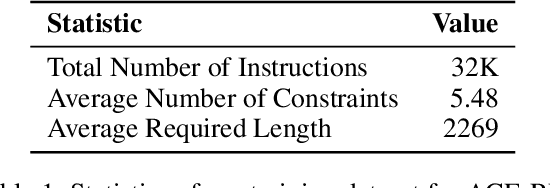
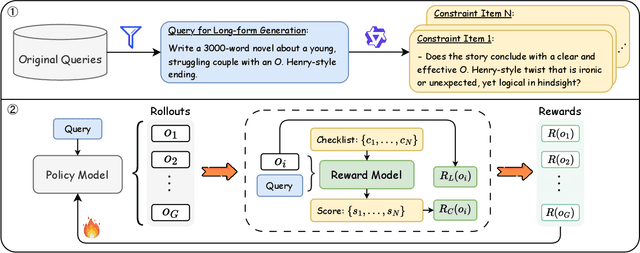
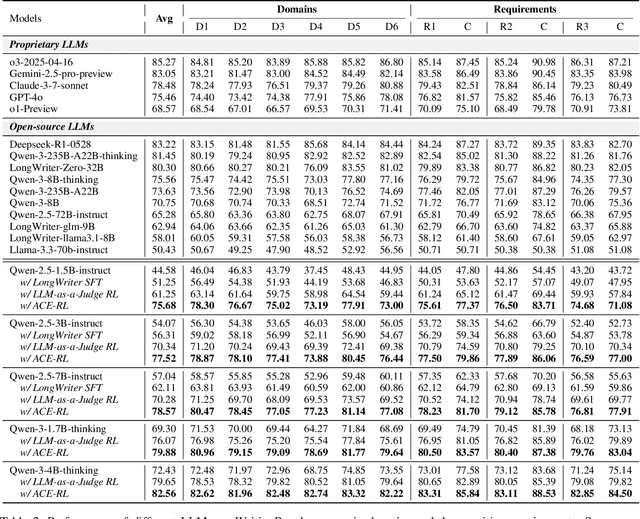
Abstract:Large Language Models (LLMs) have demonstrated remarkable progress in long-context understanding, yet they face significant challenges in high-quality long-form generation. Existing studies primarily suffer from two limitations: (1) A heavy reliance on scarce, high-quality long-form response data for supervised fine-tuning (SFT) or for pairwise preference reward in reinforcement learning (RL). (2) Focus on coarse-grained quality optimization dimensions, such as relevance, coherence, and helpfulness, overlooking the fine-grained specifics inherent to diverse long-form generation scenarios. To address this issue, we propose a framework using Adaptive Constraint-Enhanced reward for long-form generation Reinforcement Learning (ACE-RL). ACE-RL first automatically deconstructs each instruction into a set of fine-grained, adaptive constraint criteria by identifying its underlying intents and demands. Subsequently, we design a reward mechanism that quantifies the quality of long-form responses based on their satisfaction over corresponding constraints, converting subjective quality evaluation into constraint verification. Finally, we utilize reinforcement learning to guide models toward superior long-form generation capabilities. Experimental results demonstrate that our ACE-RL framework significantly outperforms existing SFT and RL baselines by 20.70% and 7.32% on WritingBench, and our top-performing model even surpasses proprietary systems like GPT-4o by 7.10%, providing a more effective training paradigm for LLMs to generate high-quality content across diverse long-form generation scenarios.
GAF: Gaussian Action Field as a Dvnamic World Model for Robotic Mlanipulation
Jun 17, 2025



Abstract:Accurate action inference is critical for vision-based robotic manipulation. Existing approaches typically follow either a Vision-to-Action (V-A) paradigm, predicting actions directly from visual inputs, or a Vision-to-3D-to-Action (V-3D-A) paradigm, leveraging intermediate 3D representations. However, these methods often struggle with action inaccuracies due to the complexity and dynamic nature of manipulation scenes. In this paper, we propose a V-4D-A framework that enables direct action reasoning from motion-aware 4D representations via a Gaussian Action Field (GAF). GAF extends 3D Gaussian Splatting (3DGS) by incorporating learnable motion attributes, allowing simultaneous modeling of dynamic scenes and manipulation actions. To learn time-varying scene geometry and action-aware robot motion, GAF supports three key query types: reconstruction of the current scene, prediction of future frames, and estimation of initial action via robot motion. Furthermore, the high-quality current and future frames generated by GAF facilitate manipulation action refinement through a GAF-guided diffusion model. Extensive experiments demonstrate significant improvements, with GAF achieving +11.5385 dB PSNR and -0.5574 LPIPS improvements in reconstruction quality, while boosting the average success rate in robotic manipulation tasks by 10.33% over state-of-the-art methods. Project page: http://chaiying1.github.io/GAF.github.io/project_page/
Group then Scale: Dynamic Mixture-of-Experts Multilingual Language Model
Jun 14, 2025Abstract:The curse of multilinguality phenomenon is a fundamental problem of multilingual Large Language Models (LLMs), where the competition between massive languages results in inferior performance. It mainly comes from limited capacity and negative transfer between dissimilar languages. To address this issue, we propose a method to dynamically group and scale up the parameters of multilingual LLM while boosting positive transfer among similar languages. Specifically, the model is first tuned on monolingual corpus to determine the parameter deviation in each layer and quantify the similarity between languages. Layers with more deviations are extended to mixture-of-experts layers to reduce competition between languages, where one expert module serves one group of similar languages. Experimental results on 18 to 128 languages show that our method reduces the negative transfer between languages and significantly boosts multilingual performance with fewer parameters. Such language group specialization on experts benefits the new language adaptation and reduces the inference on the previous multilingual knowledge learned.
SWE-Flow: Synthesizing Software Engineering Data in a Test-Driven Manner
Jun 11, 2025Abstract:We introduce **SWE-Flow**, a novel data synthesis framework grounded in Test-Driven Development (TDD). Unlike existing software engineering data that rely on human-submitted issues, **SWE-Flow** automatically infers incremental development steps directly from unit tests, which inherently encapsulate high-level requirements. The core of **SWE-Flow** is the construction of a Runtime Dependency Graph (RDG), which precisely captures function interactions, enabling the generation of a structured, step-by-step *development schedule*. At each step, **SWE-Flow** produces a partial codebase, the corresponding unit tests, and the necessary code modifications, resulting in fully verifiable TDD tasks. With this approach, we generated 16,061 training instances and 2,020 test instances from real-world GitHub projects, creating the **SWE-Flow-Eval** benchmark. Our experiments show that fine-tuning open model on this dataset significantly improves performance in TDD-based coding. To facilitate further research, we release all code, datasets, models, and Docker images at [Github](https://github.com/Hambaobao/SWE-Flow).
KTAE: A Model-Free Algorithm to Key-Tokens Advantage Estimation in Mathematical Reasoning
May 22, 2025Abstract:Recent advances have demonstrated that integrating reinforcement learning with rule-based rewards can significantly enhance the reasoning capabilities of large language models, even without supervised fine-tuning. However, prevalent reinforcement learning algorithms such as GRPO and its variants like DAPO, suffer from a coarse granularity issue when computing the advantage. Specifically, they compute rollout-level advantages that assign identical values to every token within a sequence, failing to capture token-specific contributions and hindering effective learning. To address this limitation, we propose Key-token Advantage Estimation (KTAE) - a novel algorithm that estimates fine-grained, token-level advantages without introducing additional models. KTAE leverages the correctness of sampled rollouts and applies statistical analysis to quantify the importance of individual tokens within a sequence to the final outcome. This quantified token-level importance is then combined with the rollout-level advantage to obtain a more fine-grained token-level advantage estimation. Empirical results show that models trained with GRPO+KTAE and DAPO+KTAE outperform baseline methods across five mathematical reasoning benchmarks. Notably, they achieve higher accuracy with shorter responses and even surpass R1-Distill-Qwen-1.5B using the same base model.
LENS: Multi-level Evaluation of Multimodal Reasoning with Large Language Models
May 21, 2025Abstract:Multimodal Large Language Models (MLLMs) have achieved significant advances in integrating visual and linguistic information, yet their ability to reason about complex and real-world scenarios remains limited. The existing benchmarks are usually constructed in the task-oriented manner without guarantee that different task samples come from the same data distribution, thus they often fall short in evaluating the synergistic effects of lower-level perceptual capabilities on higher-order reasoning. To lift this limitation, we contribute Lens, a multi-level benchmark with 3.4K contemporary images and 60K+ human-authored questions covering eight tasks and 12 daily scenarios, forming three progressive task tiers, i.e., perception, understanding, and reasoning. One feature is that each image is equipped with rich annotations for all tasks. Thus, this dataset intrinsically supports to evaluate MLLMs to handle image-invariable prompts, from basic perception to compositional reasoning. In addition, our images are manully collected from the social media, in which 53% were published later than Jan. 2025. We evaluate 15+ frontier MLLMs such as Qwen2.5-VL-72B, InternVL3-78B, GPT-4o and two reasoning models QVQ-72B-preview and Kimi-VL. These models are released later than Dec. 2024, and none of them achieve an accuracy greater than 60% in the reasoning tasks. Project page: https://github.com/Lens4MLLMs/lens. ICCV 2025 workshop page: https://lens4mllms.github.io/mars2-workshop-iccv2025/
Data Whisperer: Efficient Data Selection for Task-Specific LLM Fine-Tuning via Few-Shot In-Context Learning
May 18, 2025Abstract:Fine-tuning large language models (LLMs) on task-specific data is essential for their effective deployment. As dataset sizes grow, efficiently selecting optimal subsets for training becomes crucial to balancing performance and computational costs. Traditional data selection methods often require fine-tuning a scoring model on the target dataset, which is time-consuming and resource-intensive, or rely on heuristics that fail to fully leverage the model's predictive capabilities. To address these challenges, we propose Data Whisperer, an efficient, training-free, attention-based method that leverages few-shot in-context learning with the model to be fine-tuned. Comprehensive evaluations were conducted on both raw and synthetic datasets across diverse tasks and models. Notably, Data Whisperer achieves superior performance compared to the full GSM8K dataset on the Llama-3-8B-Instruct model, using just 10% of the data, and outperforms existing methods with a 3.1-point improvement and a 7.4$\times$ speedup.
Towards Scientific Intelligence: A Survey of LLM-based Scientific Agents
Mar 31, 2025



Abstract:As scientific research becomes increasingly complex, innovative tools are needed to manage vast data, facilitate interdisciplinary collaboration, and accelerate discovery. Large language models (LLMs) are now evolving into LLM-based scientific agents that automate critical tasks, ranging from hypothesis generation and experiment design to data analysis and simulation. Unlike general-purpose LLMs, these specialized agents integrate domain-specific knowledge, advanced tool sets, and robust validation mechanisms, enabling them to handle complex data types, ensure reproducibility, and drive scientific breakthroughs. This survey provides a focused review of the architectures, design, benchmarks, applications, and ethical considerations surrounding LLM-based scientific agents. We highlight why they differ from general agents and the ways in which they advance research across various scientific fields. By examining their development and challenges, this survey offers a comprehensive roadmap for researchers and practitioners to harness these agents for more efficient, reliable, and ethically sound scientific discovery.
 Add to Chrome
Add to Chrome Add to Firefox
Add to Firefox Add to Edge
Add to Edge